Contemporary Accounting Issues: IFRS and Australian Standards
VerifiedAdded on 2020/03/04
|8
|1977
|39
Report
AI Summary
This report delves into contemporary accounting issues, with a specific focus on the adoption of International Financial Reporting Standards (IFRS) in Australia. It begins by outlining the importance of accounting in business operations, emphasizing its role in performance evaluation, financial analysis, and adherence to statutory requirements. The report then introduces the conceptual framework for accounting, highlighting the role of the International Accounting Standards Board (IASB) in establishing standards. It explores the adoption of IFRS by the Australian Accounting Standards Board (AASB), detailing the changes made to adapt IFRS for the Australian context (A-IFRS). The report further examines the implications of IFRS adoption, including increased transparency and comparability. It analyzes the annual reports of TPG Telecom Ltd and Woolworths Group, highlighting their compliance with IFRS and the adoption of new standards like AASB 9, AASB 15, and AASB 16. Finally, the report investigates the impact of IFRS adoption on Australian companies, referencing research on its effects on investors, analysts, and the overall quality of accounting practices. The report concludes with a call for further research to fully understand the implications of IFRS adoption.
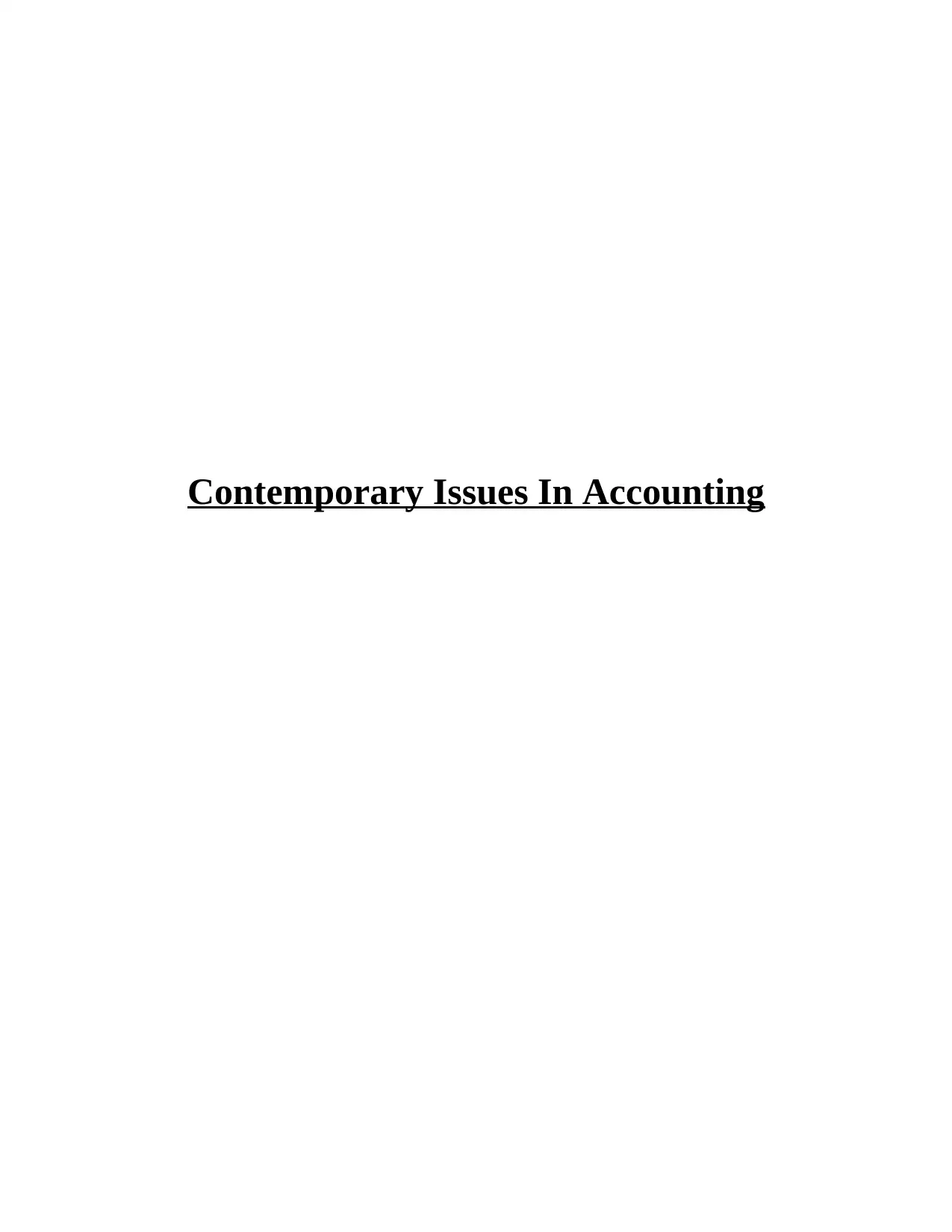
Contemporary Issues In Accounting
Paraphrase This Document
Need a fresh take? Get an instant paraphrase of this document with our AI Paraphraser
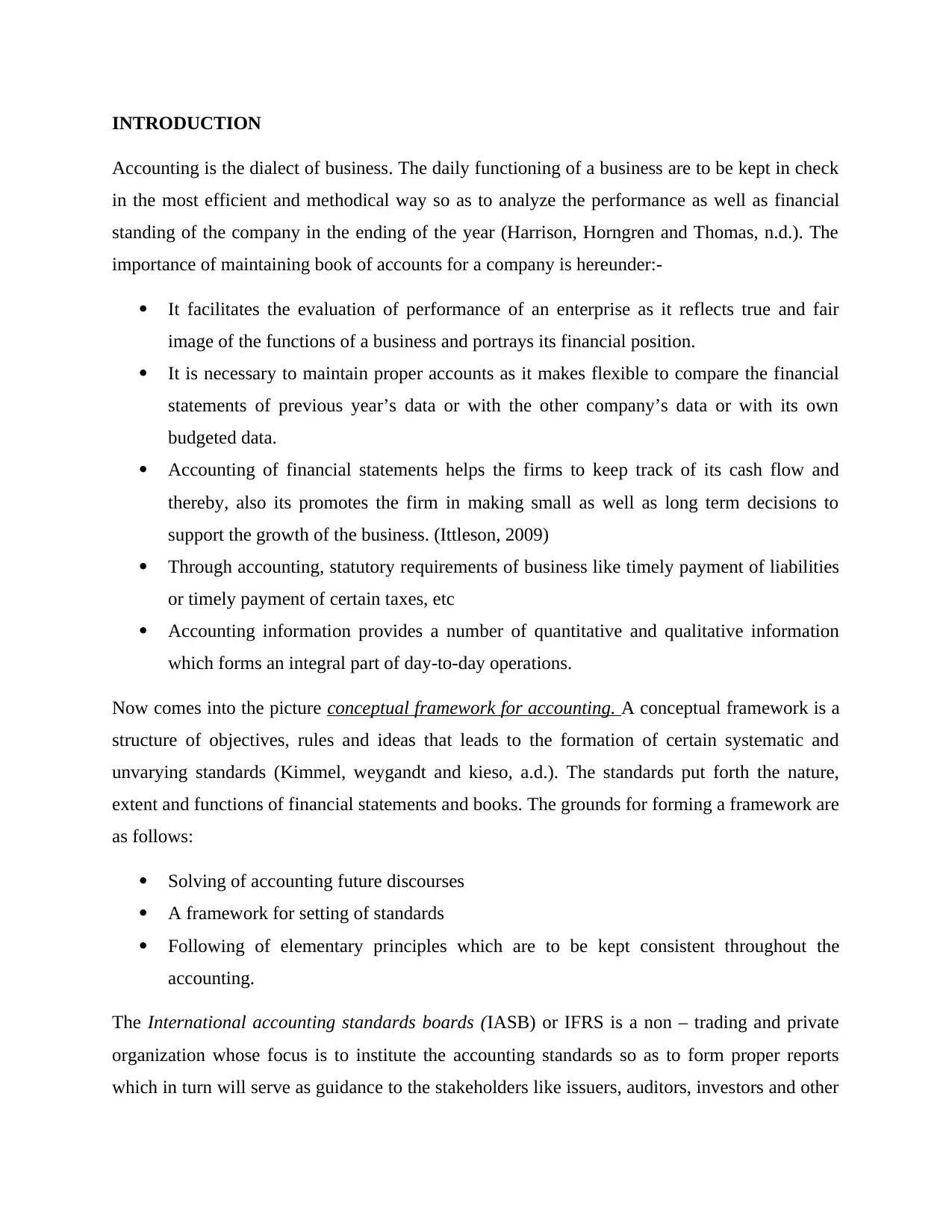
INTRODUCTION
Accounting is the dialect of business. The daily functioning of a business are to be kept in check
in the most efficient and methodical way so as to analyze the performance as well as financial
standing of the company in the ending of the year (Harrison, Horngren and Thomas, n.d.). The
importance of maintaining book of accounts for a company is hereunder:-
It facilitates the evaluation of performance of an enterprise as it reflects true and fair
image of the functions of a business and portrays its financial position.
It is necessary to maintain proper accounts as it makes flexible to compare the financial
statements of previous year’s data or with the other company’s data or with its own
budgeted data.
Accounting of financial statements helps the firms to keep track of its cash flow and
thereby, also its promotes the firm in making small as well as long term decisions to
support the growth of the business. (Ittleson, 2009)
Through accounting, statutory requirements of business like timely payment of liabilities
or timely payment of certain taxes, etc
Accounting information provides a number of quantitative and qualitative information
which forms an integral part of day-to-day operations.
Now comes into the picture conceptual framework for accounting. A conceptual framework is a
structure of objectives, rules and ideas that leads to the formation of certain systematic and
unvarying standards (Kimmel, weygandt and kieso, a.d.). The standards put forth the nature,
extent and functions of financial statements and books. The grounds for forming a framework are
as follows:
Solving of accounting future discourses
A framework for setting of standards
Following of elementary principles which are to be kept consistent throughout the
accounting.
The International accounting standards boards (IASB) or IFRS is a non – trading and private
organization whose focus is to institute the accounting standards so as to form proper reports
which in turn will serve as guidance to the stakeholders like issuers, auditors, investors and other
Accounting is the dialect of business. The daily functioning of a business are to be kept in check
in the most efficient and methodical way so as to analyze the performance as well as financial
standing of the company in the ending of the year (Harrison, Horngren and Thomas, n.d.). The
importance of maintaining book of accounts for a company is hereunder:-
It facilitates the evaluation of performance of an enterprise as it reflects true and fair
image of the functions of a business and portrays its financial position.
It is necessary to maintain proper accounts as it makes flexible to compare the financial
statements of previous year’s data or with the other company’s data or with its own
budgeted data.
Accounting of financial statements helps the firms to keep track of its cash flow and
thereby, also its promotes the firm in making small as well as long term decisions to
support the growth of the business. (Ittleson, 2009)
Through accounting, statutory requirements of business like timely payment of liabilities
or timely payment of certain taxes, etc
Accounting information provides a number of quantitative and qualitative information
which forms an integral part of day-to-day operations.
Now comes into the picture conceptual framework for accounting. A conceptual framework is a
structure of objectives, rules and ideas that leads to the formation of certain systematic and
unvarying standards (Kimmel, weygandt and kieso, a.d.). The standards put forth the nature,
extent and functions of financial statements and books. The grounds for forming a framework are
as follows:
Solving of accounting future discourses
A framework for setting of standards
Following of elementary principles which are to be kept consistent throughout the
accounting.
The International accounting standards boards (IASB) or IFRS is a non – trading and private
organization whose focus is to institute the accounting standards so as to form proper reports
which in turn will serve as guidance to the stakeholders like issuers, auditors, investors and other
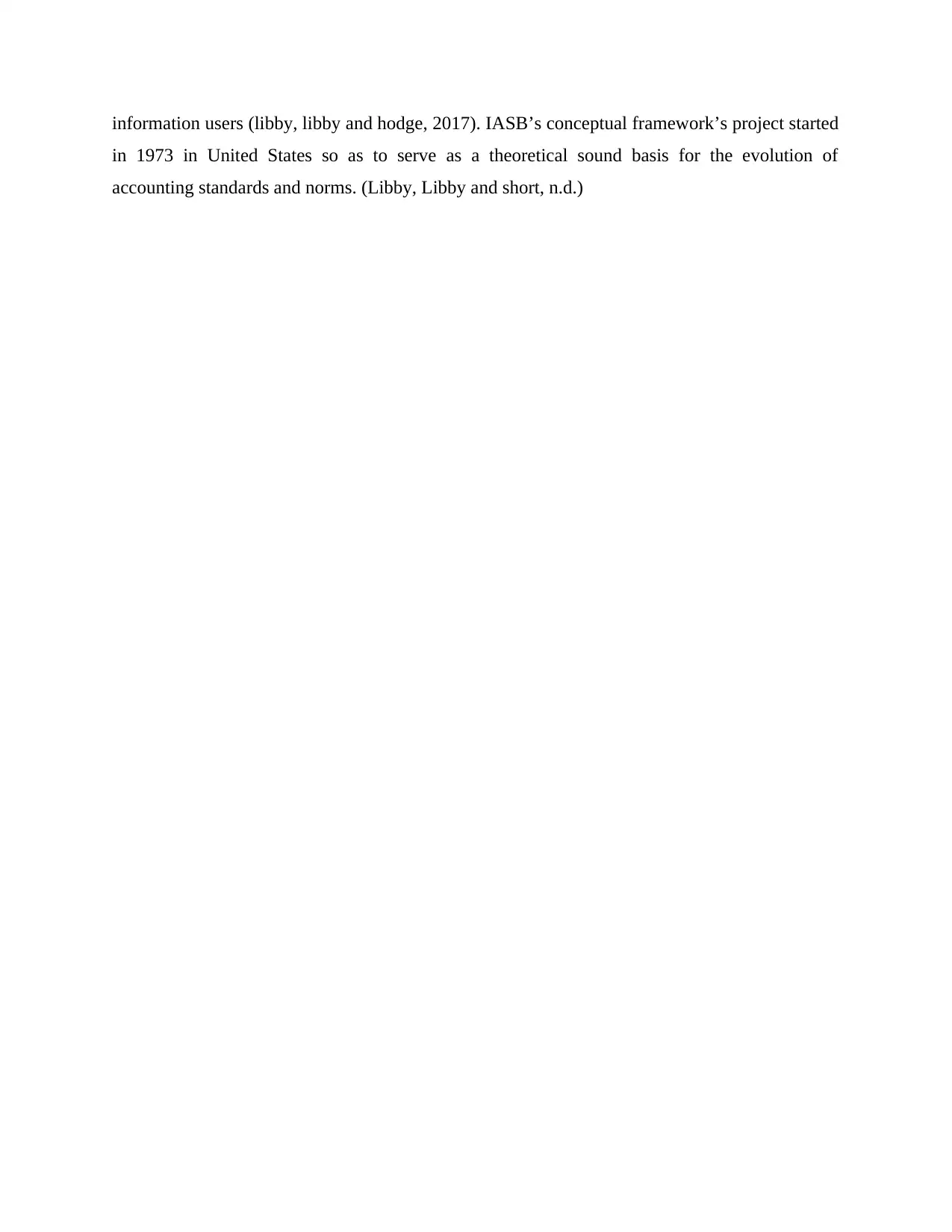
information users (libby, libby and hodge, 2017). IASB’s conceptual framework’s project started
in 1973 in United States so as to serve as a theoretical sound basis for the evolution of
accounting standards and norms. (Libby, Libby and short, n.d.)
in 1973 in United States so as to serve as a theoretical sound basis for the evolution of
accounting standards and norms. (Libby, Libby and short, n.d.)
⊘ This is a preview!⊘
Do you want full access?
Subscribe today to unlock all pages.

Trusted by 1+ million students worldwide
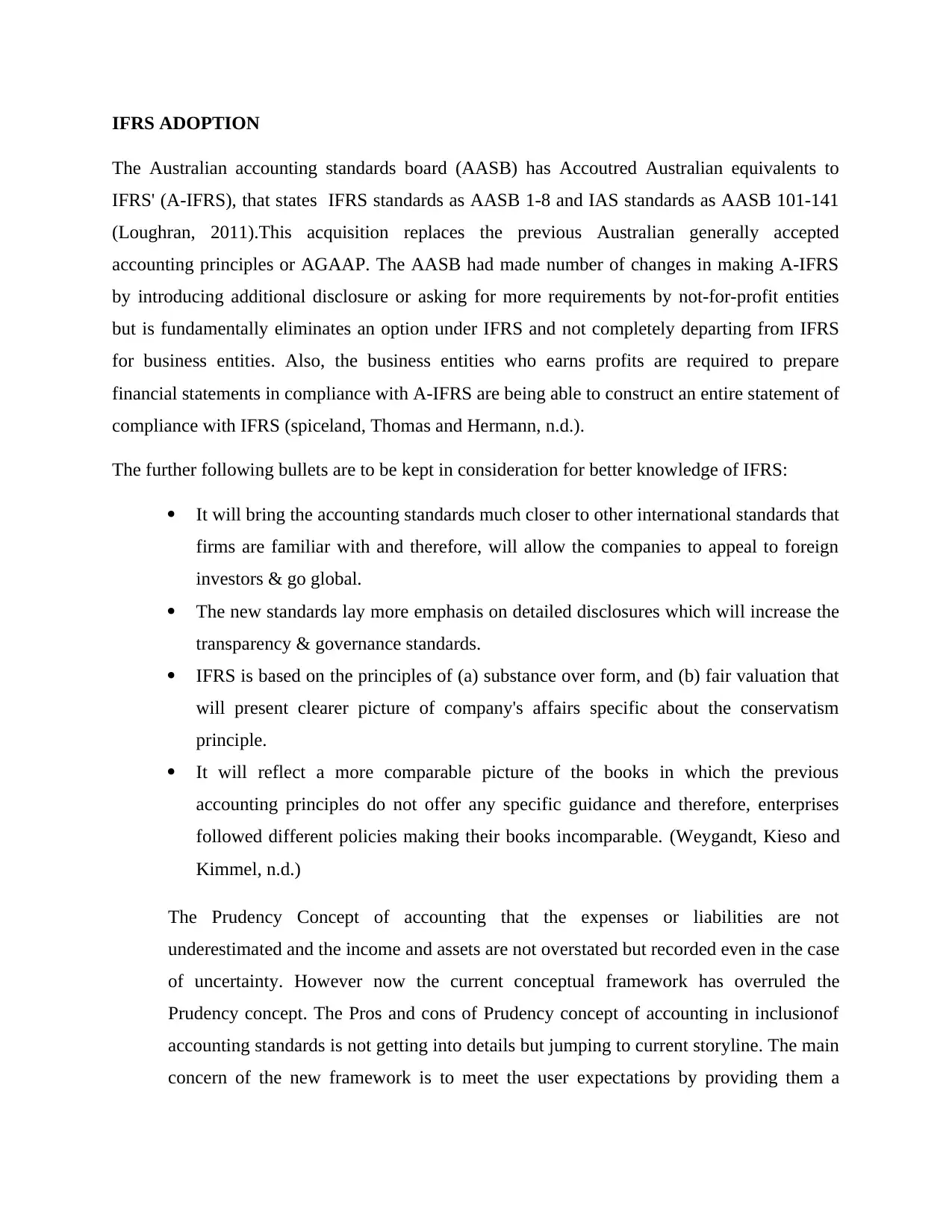
IFRS ADOPTION
The Australian accounting standards board (AASB) has Accoutred Australian equivalents to
IFRS' (A-IFRS), that states IFRS standards as AASB 1-8 and IAS standards as AASB 101-141
(Loughran, 2011).This acquisition replaces the previous Australian generally accepted
accounting principles or AGAAP. The AASB had made number of changes in making A-IFRS
by introducing additional disclosure or asking for more requirements by not-for-profit entities
but is fundamentally eliminates an option under IFRS and not completely departing from IFRS
for business entities. Also, the business entities who earns profits are required to prepare
financial statements in compliance with A-IFRS are being able to construct an entire statement of
compliance with IFRS (spiceland, Thomas and Hermann, n.d.).
The further following bullets are to be kept in consideration for better knowledge of IFRS:
It will bring the accounting standards much closer to other international standards that
firms are familiar with and therefore, will allow the companies to appeal to foreign
investors & go global.
The new standards lay more emphasis on detailed disclosures which will increase the
transparency & governance standards.
IFRS is based on the principles of (a) substance over form, and (b) fair valuation that
will present clearer picture of company's affairs specific about the conservatism
principle.
It will reflect a more comparable picture of the books in which the previous
accounting principles do not offer any specific guidance and therefore, enterprises
followed different policies making their books incomparable. (Weygandt, Kieso and
Kimmel, n.d.)
The Prudency Concept of accounting that the expenses or liabilities are not
underestimated and the income and assets are not overstated but recorded even in the case
of uncertainty. However now the current conceptual framework has overruled the
Prudency concept. The Pros and cons of Prudency concept of accounting in inclusionof
accounting standards is not getting into details but jumping to current storyline. The main
concern of the new framework is to meet the user expectations by providing them a
The Australian accounting standards board (AASB) has Accoutred Australian equivalents to
IFRS' (A-IFRS), that states IFRS standards as AASB 1-8 and IAS standards as AASB 101-141
(Loughran, 2011).This acquisition replaces the previous Australian generally accepted
accounting principles or AGAAP. The AASB had made number of changes in making A-IFRS
by introducing additional disclosure or asking for more requirements by not-for-profit entities
but is fundamentally eliminates an option under IFRS and not completely departing from IFRS
for business entities. Also, the business entities who earns profits are required to prepare
financial statements in compliance with A-IFRS are being able to construct an entire statement of
compliance with IFRS (spiceland, Thomas and Hermann, n.d.).
The further following bullets are to be kept in consideration for better knowledge of IFRS:
It will bring the accounting standards much closer to other international standards that
firms are familiar with and therefore, will allow the companies to appeal to foreign
investors & go global.
The new standards lay more emphasis on detailed disclosures which will increase the
transparency & governance standards.
IFRS is based on the principles of (a) substance over form, and (b) fair valuation that
will present clearer picture of company's affairs specific about the conservatism
principle.
It will reflect a more comparable picture of the books in which the previous
accounting principles do not offer any specific guidance and therefore, enterprises
followed different policies making their books incomparable. (Weygandt, Kieso and
Kimmel, n.d.)
The Prudency Concept of accounting that the expenses or liabilities are not
underestimated and the income and assets are not overstated but recorded even in the case
of uncertainty. However now the current conceptual framework has overruled the
Prudency concept. The Pros and cons of Prudency concept of accounting in inclusionof
accounting standards is not getting into details but jumping to current storyline. The main
concern of the new framework is to meet the user expectations by providing them a
Paraphrase This Document
Need a fresh take? Get an instant paraphrase of this document with our AI Paraphraser
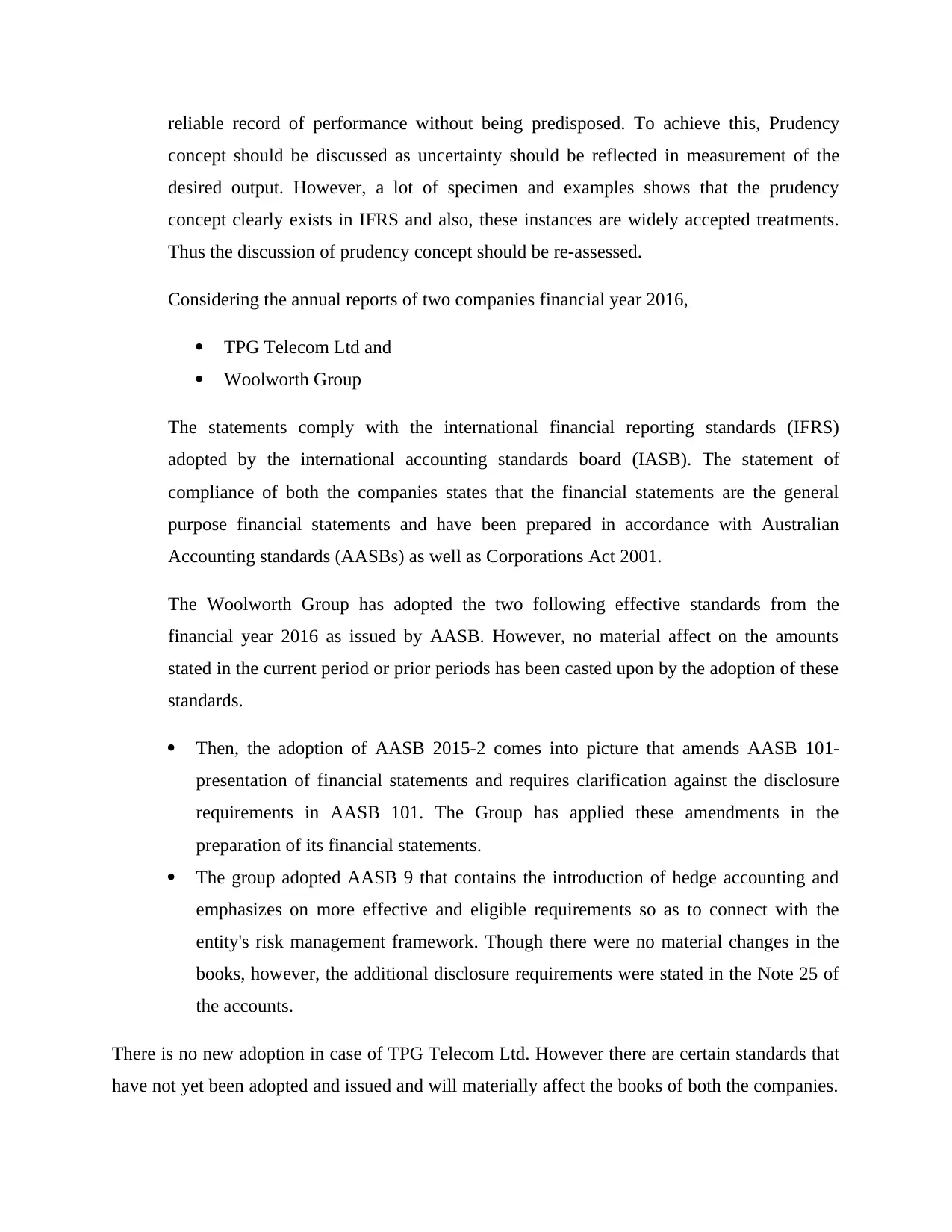
reliable record of performance without being predisposed. To achieve this, Prudency
concept should be discussed as uncertainty should be reflected in measurement of the
desired output. However, a lot of specimen and examples shows that the prudency
concept clearly exists in IFRS and also, these instances are widely accepted treatments.
Thus the discussion of prudency concept should be re-assessed.
Considering the annual reports of two companies financial year 2016,
TPG Telecom Ltd and
Woolworth Group
The statements comply with the international financial reporting standards (IFRS)
adopted by the international accounting standards board (IASB). The statement of
compliance of both the companies states that the financial statements are the general
purpose financial statements and have been prepared in accordance with Australian
Accounting standards (AASBs) as well as Corporations Act 2001.
The Woolworth Group has adopted the two following effective standards from the
financial year 2016 as issued by AASB. However, no material affect on the amounts
stated in the current period or prior periods has been casted upon by the adoption of these
standards.
Then, the adoption of AASB 2015-2 comes into picture that amends AASB 101-
presentation of financial statements and requires clarification against the disclosure
requirements in AASB 101. The Group has applied these amendments in the
preparation of its financial statements.
The group adopted AASB 9 that contains the introduction of hedge accounting and
emphasizes on more effective and eligible requirements so as to connect with the
entity's risk management framework. Though there were no material changes in the
books, however, the additional disclosure requirements were stated in the Note 25 of
the accounts.
There is no new adoption in case of TPG Telecom Ltd. However there are certain standards that
have not yet been adopted and issued and will materially affect the books of both the companies.
concept should be discussed as uncertainty should be reflected in measurement of the
desired output. However, a lot of specimen and examples shows that the prudency
concept clearly exists in IFRS and also, these instances are widely accepted treatments.
Thus the discussion of prudency concept should be re-assessed.
Considering the annual reports of two companies financial year 2016,
TPG Telecom Ltd and
Woolworth Group
The statements comply with the international financial reporting standards (IFRS)
adopted by the international accounting standards board (IASB). The statement of
compliance of both the companies states that the financial statements are the general
purpose financial statements and have been prepared in accordance with Australian
Accounting standards (AASBs) as well as Corporations Act 2001.
The Woolworth Group has adopted the two following effective standards from the
financial year 2016 as issued by AASB. However, no material affect on the amounts
stated in the current period or prior periods has been casted upon by the adoption of these
standards.
Then, the adoption of AASB 2015-2 comes into picture that amends AASB 101-
presentation of financial statements and requires clarification against the disclosure
requirements in AASB 101. The Group has applied these amendments in the
preparation of its financial statements.
The group adopted AASB 9 that contains the introduction of hedge accounting and
emphasizes on more effective and eligible requirements so as to connect with the
entity's risk management framework. Though there were no material changes in the
books, however, the additional disclosure requirements were stated in the Note 25 of
the accounts.
There is no new adoption in case of TPG Telecom Ltd. However there are certain standards that
have not yet been adopted and issued and will materially affect the books of both the companies.
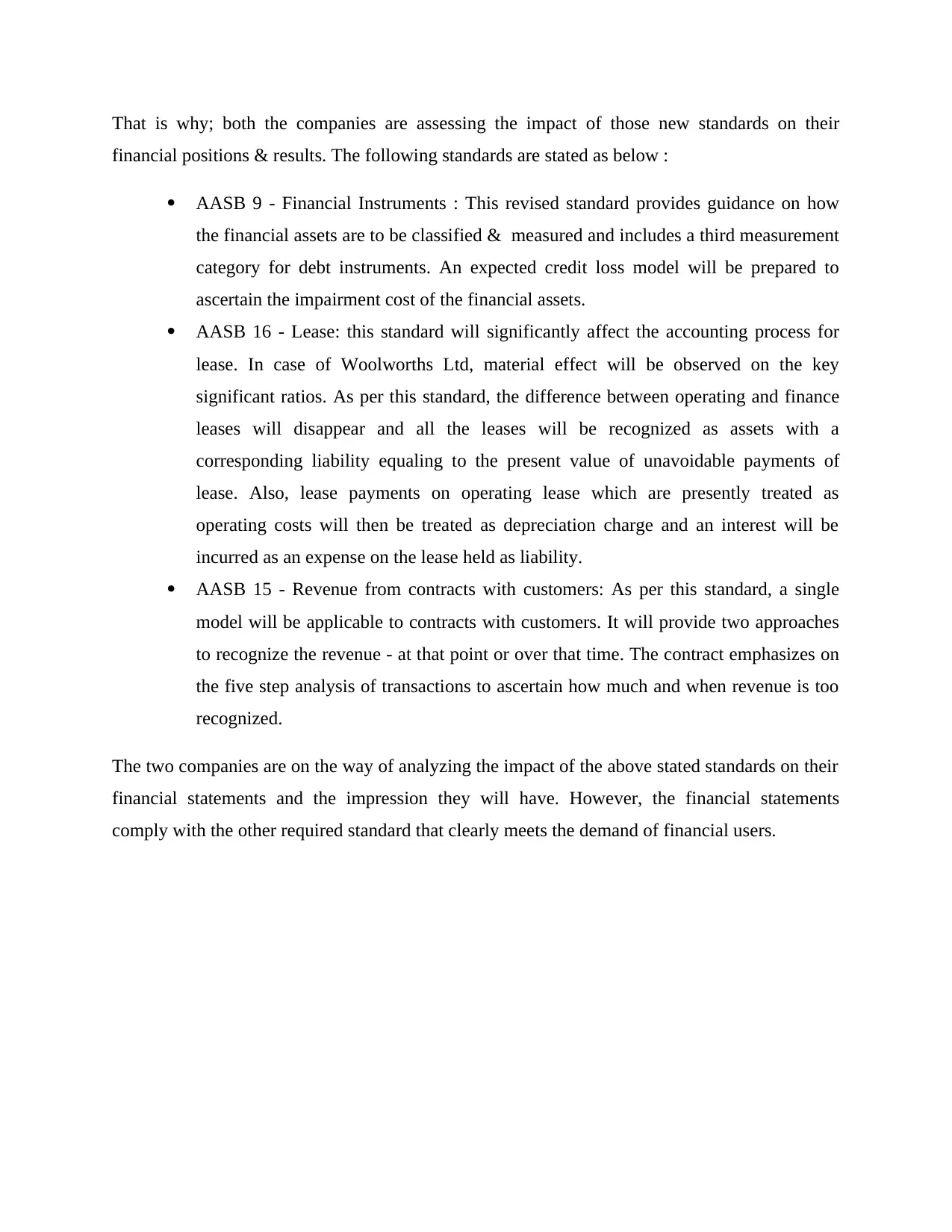
That is why; both the companies are assessing the impact of those new standards on their
financial positions & results. The following standards are stated as below :
AASB 9 - Financial Instruments : This revised standard provides guidance on how
the financial assets are to be classified & measured and includes a third measurement
category for debt instruments. An expected credit loss model will be prepared to
ascertain the impairment cost of the financial assets.
AASB 16 - Lease: this standard will significantly affect the accounting process for
lease. In case of Woolworths Ltd, material effect will be observed on the key
significant ratios. As per this standard, the difference between operating and finance
leases will disappear and all the leases will be recognized as assets with a
corresponding liability equaling to the present value of unavoidable payments of
lease. Also, lease payments on operating lease which are presently treated as
operating costs will then be treated as depreciation charge and an interest will be
incurred as an expense on the lease held as liability.
AASB 15 - Revenue from contracts with customers: As per this standard, a single
model will be applicable to contracts with customers. It will provide two approaches
to recognize the revenue - at that point or over that time. The contract emphasizes on
the five step analysis of transactions to ascertain how much and when revenue is too
recognized.
The two companies are on the way of analyzing the impact of the above stated standards on their
financial statements and the impression they will have. However, the financial statements
comply with the other required standard that clearly meets the demand of financial users.
financial positions & results. The following standards are stated as below :
AASB 9 - Financial Instruments : This revised standard provides guidance on how
the financial assets are to be classified & measured and includes a third measurement
category for debt instruments. An expected credit loss model will be prepared to
ascertain the impairment cost of the financial assets.
AASB 16 - Lease: this standard will significantly affect the accounting process for
lease. In case of Woolworths Ltd, material effect will be observed on the key
significant ratios. As per this standard, the difference between operating and finance
leases will disappear and all the leases will be recognized as assets with a
corresponding liability equaling to the present value of unavoidable payments of
lease. Also, lease payments on operating lease which are presently treated as
operating costs will then be treated as depreciation charge and an interest will be
incurred as an expense on the lease held as liability.
AASB 15 - Revenue from contracts with customers: As per this standard, a single
model will be applicable to contracts with customers. It will provide two approaches
to recognize the revenue - at that point or over that time. The contract emphasizes on
the five step analysis of transactions to ascertain how much and when revenue is too
recognized.
The two companies are on the way of analyzing the impact of the above stated standards on their
financial statements and the impression they will have. However, the financial statements
comply with the other required standard that clearly meets the demand of financial users.
⊘ This is a preview!⊘
Do you want full access?
Subscribe today to unlock all pages.

Trusted by 1+ million students worldwide
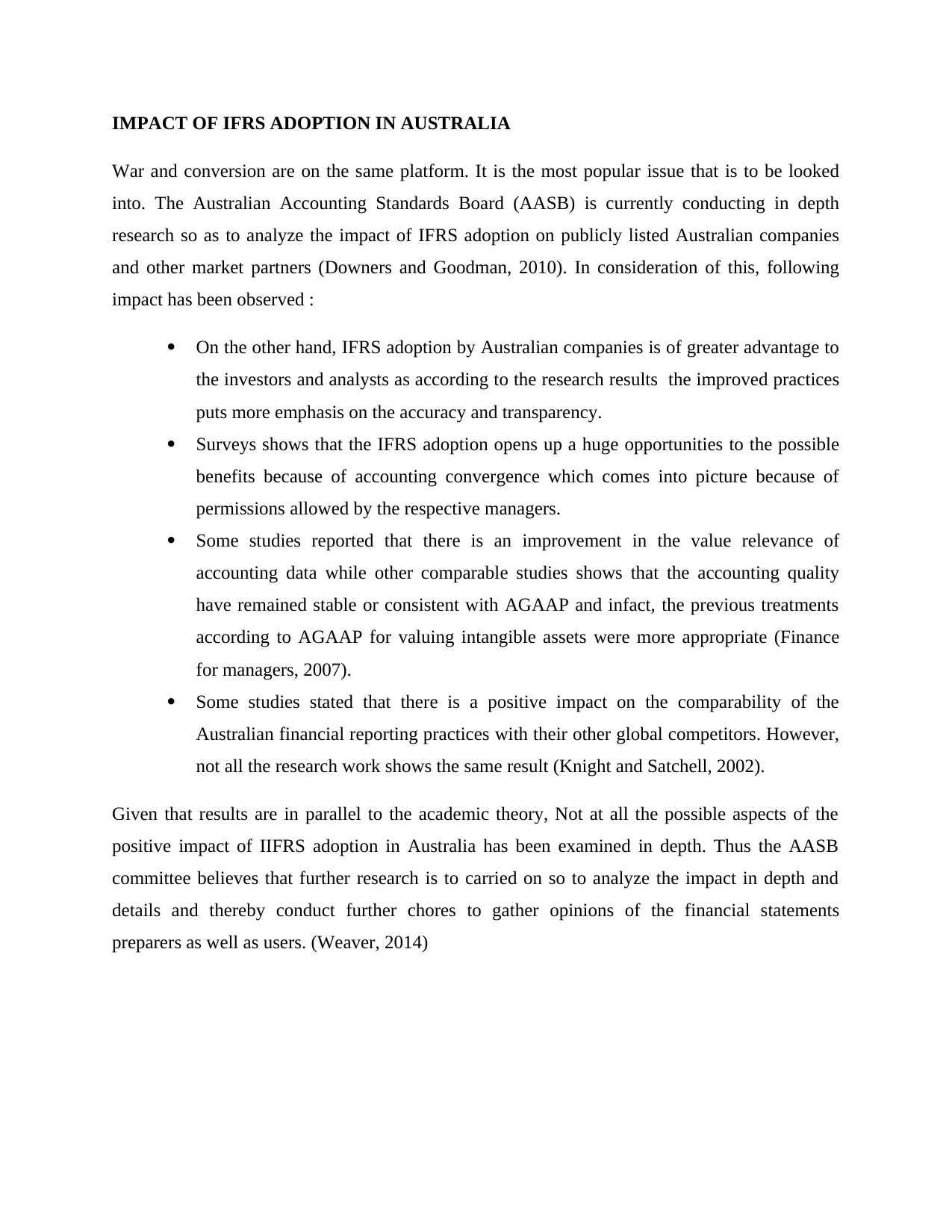
IMPACT OF IFRS ADOPTION IN AUSTRALIA
War and conversion are on the same platform. It is the most popular issue that is to be looked
into. The Australian Accounting Standards Board (AASB) is currently conducting in depth
research so as to analyze the impact of IFRS adoption on publicly listed Australian companies
and other market partners (Downers and Goodman, 2010). In consideration of this, following
impact has been observed :
On the other hand, IFRS adoption by Australian companies is of greater advantage to
the investors and analysts as according to the research results the improved practices
puts more emphasis on the accuracy and transparency.
Surveys shows that the IFRS adoption opens up a huge opportunities to the possible
benefits because of accounting convergence which comes into picture because of
permissions allowed by the respective managers.
Some studies reported that there is an improvement in the value relevance of
accounting data while other comparable studies shows that the accounting quality
have remained stable or consistent with AGAAP and infact, the previous treatments
according to AGAAP for valuing intangible assets were more appropriate (Finance
for managers, 2007).
Some studies stated that there is a positive impact on the comparability of the
Australian financial reporting practices with their other global competitors. However,
not all the research work shows the same result (Knight and Satchell, 2002).
Given that results are in parallel to the academic theory, Not at all the possible aspects of the
positive impact of IIFRS adoption in Australia has been examined in depth. Thus the AASB
committee believes that further research is to carried on so to analyze the impact in depth and
details and thereby conduct further chores to gather opinions of the financial statements
preparers as well as users. (Weaver, 2014)
War and conversion are on the same platform. It is the most popular issue that is to be looked
into. The Australian Accounting Standards Board (AASB) is currently conducting in depth
research so as to analyze the impact of IFRS adoption on publicly listed Australian companies
and other market partners (Downers and Goodman, 2010). In consideration of this, following
impact has been observed :
On the other hand, IFRS adoption by Australian companies is of greater advantage to
the investors and analysts as according to the research results the improved practices
puts more emphasis on the accuracy and transparency.
Surveys shows that the IFRS adoption opens up a huge opportunities to the possible
benefits because of accounting convergence which comes into picture because of
permissions allowed by the respective managers.
Some studies reported that there is an improvement in the value relevance of
accounting data while other comparable studies shows that the accounting quality
have remained stable or consistent with AGAAP and infact, the previous treatments
according to AGAAP for valuing intangible assets were more appropriate (Finance
for managers, 2007).
Some studies stated that there is a positive impact on the comparability of the
Australian financial reporting practices with their other global competitors. However,
not all the research work shows the same result (Knight and Satchell, 2002).
Given that results are in parallel to the academic theory, Not at all the possible aspects of the
positive impact of IIFRS adoption in Australia has been examined in depth. Thus the AASB
committee believes that further research is to carried on so to analyze the impact in depth and
details and thereby conduct further chores to gather opinions of the financial statements
preparers as well as users. (Weaver, 2014)
Paraphrase This Document
Need a fresh take? Get an instant paraphrase of this document with our AI Paraphraser
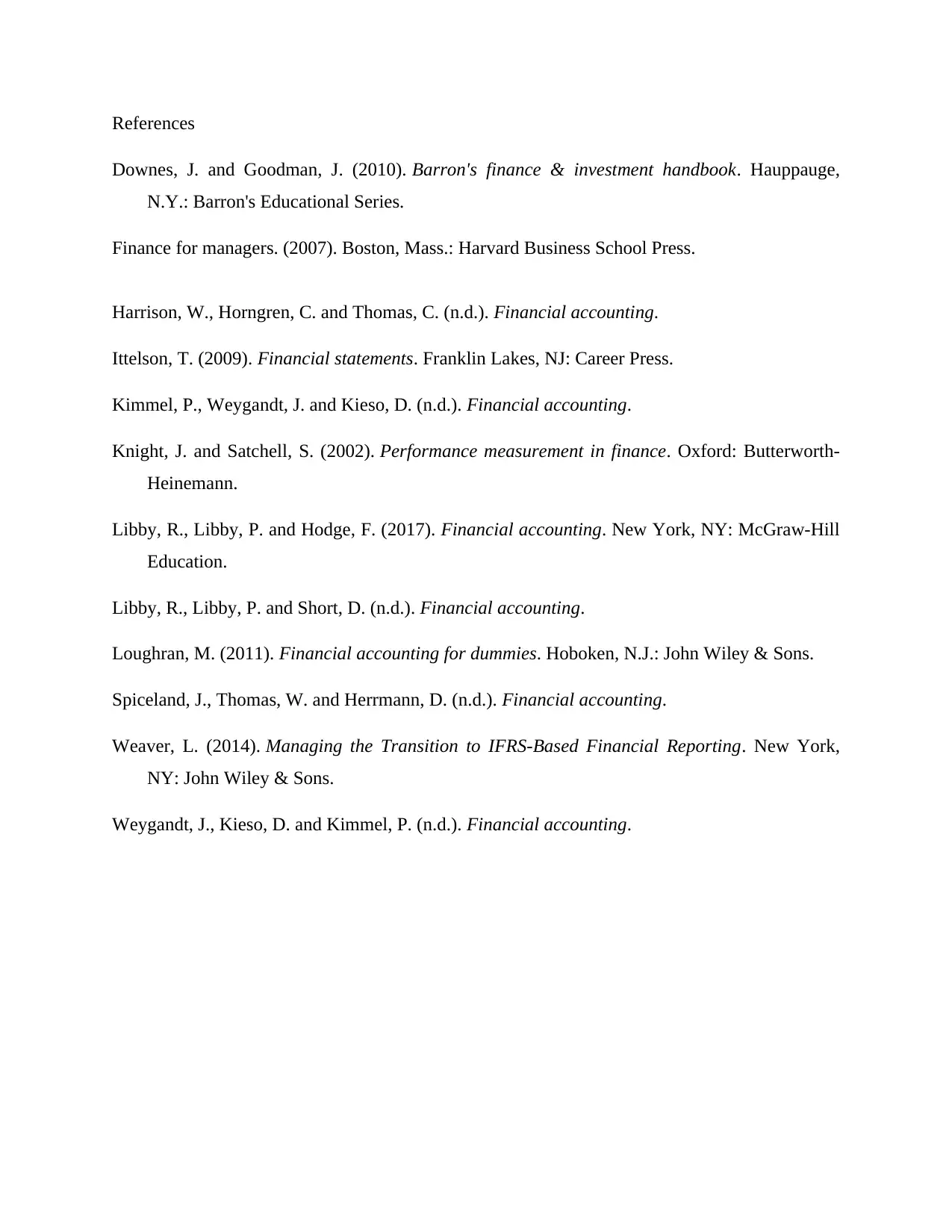
References
Downes, J. and Goodman, J. (2010). Barron's finance & investment handbook. Hauppauge,
N.Y.: Barron's Educational Series.
Finance for managers. (2007). Boston, Mass.: Harvard Business School Press.
Harrison, W., Horngren, C. and Thomas, C. (n.d.). Financial accounting.
Ittelson, T. (2009). Financial statements. Franklin Lakes, NJ: Career Press.
Kimmel, P., Weygandt, J. and Kieso, D. (n.d.). Financial accounting.
Knight, J. and Satchell, S. (2002). Performance measurement in finance. Oxford: Butterworth-
Heinemann.
Libby, R., Libby, P. and Hodge, F. (2017). Financial accounting. New York, NY: McGraw-Hill
Education.
Libby, R., Libby, P. and Short, D. (n.d.). Financial accounting.
Loughran, M. (2011). Financial accounting for dummies. Hoboken, N.J.: John Wiley & Sons.
Spiceland, J., Thomas, W. and Herrmann, D. (n.d.). Financial accounting.
Weaver, L. (2014). Managing the Transition to IFRS-Based Financial Reporting. New York,
NY: John Wiley & Sons.
Weygandt, J., Kieso, D. and Kimmel, P. (n.d.). Financial accounting.
Downes, J. and Goodman, J. (2010). Barron's finance & investment handbook. Hauppauge,
N.Y.: Barron's Educational Series.
Finance for managers. (2007). Boston, Mass.: Harvard Business School Press.
Harrison, W., Horngren, C. and Thomas, C. (n.d.). Financial accounting.
Ittelson, T. (2009). Financial statements. Franklin Lakes, NJ: Career Press.
Kimmel, P., Weygandt, J. and Kieso, D. (n.d.). Financial accounting.
Knight, J. and Satchell, S. (2002). Performance measurement in finance. Oxford: Butterworth-
Heinemann.
Libby, R., Libby, P. and Hodge, F. (2017). Financial accounting. New York, NY: McGraw-Hill
Education.
Libby, R., Libby, P. and Short, D. (n.d.). Financial accounting.
Loughran, M. (2011). Financial accounting for dummies. Hoboken, N.J.: John Wiley & Sons.
Spiceland, J., Thomas, W. and Herrmann, D. (n.d.). Financial accounting.
Weaver, L. (2014). Managing the Transition to IFRS-Based Financial Reporting. New York,
NY: John Wiley & Sons.
Weygandt, J., Kieso, D. and Kimmel, P. (n.d.). Financial accounting.
1 out of 8
Related Documents
Your All-in-One AI-Powered Toolkit for Academic Success.
+13062052269
info@desklib.com
Available 24*7 on WhatsApp / Email
![[object Object]](/_next/static/media/star-bottom.7253800d.svg)
Unlock your academic potential
Copyright © 2020–2025 A2Z Services. All Rights Reserved. Developed and managed by ZUCOL.



